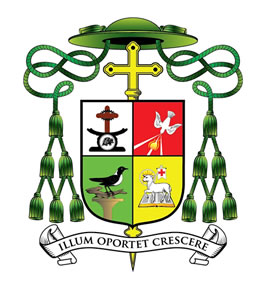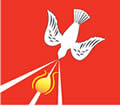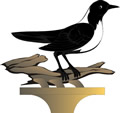Explanation of the Bishop's crest

 |
1. In the right upper corner of the crest is the symbol of the Holy Spirit. It is the Holy Spirit who calls and equips us in ministry. This is evident throughout Sacred Scripture from Abraham, through Moses, to the prophets, John the Baptist, Mary, Paul etc. I cannot attribute my call to this office to any other than the Holy Spirit. Believing in the continuous guidance, presence, and assistance of the Holy Spirit. He will equip me with every spiritual gift in the heavenly places to accomplish this awesome call as the prophet Zachariah aptly puts it “not by might, not by power, but by my Spirit says the Lord of host” (Zac 4:6). |
 |
2. In the right lower corner of the crest is the symbol of the Word and the Lamb of God, Jesus. John said "behold the Lamb of God who takes away the sins of the world" The entire ministry of John was to direct people to Jesus, the Saviour. He is the one every heart is yearning and hungry for. As a bishop, I want to bring everyone to Jesus, to receive Him in His word and to partake in the sacred body and blood of the lamb. |
 |
3. In the lower left corner of the crest is the Crow which is the totem of the Asona clan to which the bishop belongs. The Crow symbolizes beauty which is characteristic of the Asona. The Crow is a hardworking bird and its persistence and untiring efforts are always crowned with success, hence the white color around the neck. |
 |
4. In the upper left corner of the crest is a Traditional Stool with a Cross on top and the image of the porcupine in the centre of it. The Traditional stool symbolizes the bishop’s seat (Cathedra in Latin). The Cathedra represents the pastoral and administrative authority of the bishop in the diocese. The cross on the stool reminds us of Christ the King who reigns above the bishop. The stool with the cross constitutes the official symbolic representation of Obuasi Diocese. The cross constantly reminds the Bishop to love the people of God as our Lord Jesus Christ did, in total self-giving. The Porcupine is the symbol of the Asante Nation. The Porcupine has long sharp stiff spines or quills that it shoots out in self-defense when attached. It is believed that when it shoots out a thousand quills at an attacker, a thousand new quills spring up. It is the symbol of resilience and indomitability for the Asante Nation to which the bishop belongs. |
 |
5. The motto: "illum oportet crescere" He must increase (and I must decrease, cf. John 3:30) is a statement that epitomizes the virtue of Humility which characterizes the ministry of St. John the Baptist, the forerunner of Jesus. In his humility John withdrew to the backstage to pave way for Jesus’ ministry to flourish. Like my patron saint, I zealously embrace this new ministry to constantly and passionately call people to repentance and to speak and stand for the truth, for which John the Baptist suffered martyrdom in the spirit of humility. |


